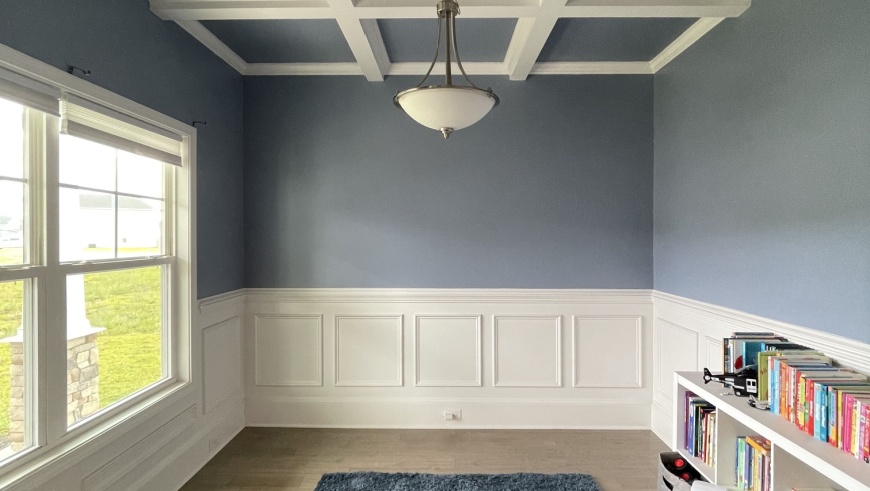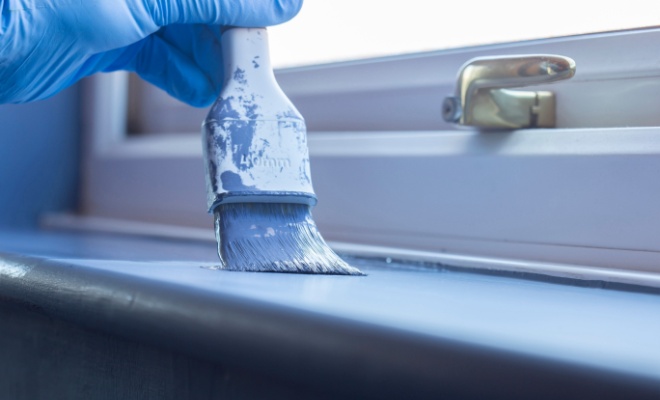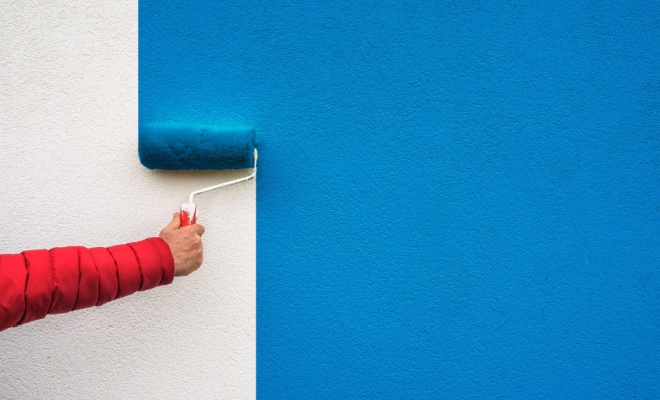Cost to Paint a Room
Last updated 20th May, 2025
How much does it cost to paint a room?
This article outlines the prices involved in interior house painting. We look at how to paint a room, the wall paint cost, and typical painter decorator prices. You can expect a range of about £250-£300 for the average cost to paint a room.
Continue reading below for more information!

Table of Contents
How Much to Paint a Room?
If we assume that you have prepared the room for the decorators by removing the furniture and contents, or at least have them placed in the centre of the room providing easy access to the walls, then an average size room will cost around £250-£300.
What is included:
- Preparation
- Cleaning the walls
- Minor repairs with filler
- Two coats of paint
What isn't included:
- Lifting or moving carpets
- Removing wallpaper
- Painting window sills
- Painting skirting boards
- Painting doors/doorframes
- Extensive wall repairs
How much will a painter cost?
Most painters and decorators charge about £150-£200 per day in labour costs and quite often work in pairs if the job is a large one. For a single room the job shouldn't take any longer than a few hours but often the tradesmen will leave and come back the next day to apply a second coat.
For this reason it's often a good idea to have 2 or 3 rooms decorated at the same time as it will save you money if you plan on having them painted in the near future.
Room Painting Prices
Here are a few average costs for hiring a painter and decorator to do internal painting and decorating.
Where wallpaper is removed or woodwork painted the price includes prepping the surfaces, i.e. sugar soap, sanding, small repair work, and lining paper if necessary.
| Job Description | Avg. Cost | Duration |
|---|---|---|
| Single room needs painting | £250 | 4-8 hours |
| 2 rooms need painting | £350 | 4-8 hours |
| Single room needs stripping, prepping and then painting | £350 | 1-2 days |
| 2 rooms need stripping, prepping and then painting | £500 | 2-3 days |
| Single room needs painting including all woodwork | £500 | 2-3 days |
Room Painting Cost Breakdown Calculator
Individual costs for hiring a decorator to paint the walls of a single average sized room: £250
Materials
£50
Tradesmen
£200
Waste Removal
£0
What Does Painting a Room Involve?
When it comes to interior painting, most painters and decorators will expect the furniture and contents of the room to be removed by the occupant, with any remaining items placed in the centre of the room away from any walls that are to be painted.
Normally the painting will be done with the carpet left in place. Any quotes you gather for this job will normally include preparing the walls for the paint (which includes any minor repairs required for a smooth surface), then typically two coats of decent quality emulsion.

The window sills, skirting boards and doors are not normally included in any painting quotes for a room unless you specifically ask for them to be included.
It is normally a good idea to have any timber painted at the same time for the best finish, freshly painted walls and ceilings with grubby window sills and door frames will look awful, so budget a bit extra to have them included.
Interior painting is a common DIY job and as long as you buy decent quality paint and have the patience and skills for it, a good finish can be achieved. DIY painting is obviously much cheaper, but it would be unusual for a DIY enthusiast to achieve the same standard of finish as a professional painter.
Optimum Painting Temperature
The temperature of your house affects the performance of paint.
The wall temperature can vary considerably with the weather and when painting you should try and make sure it is above 10°C and below 35°C, so avoid painting when it's really hot or really cold — common sense really!
For exterior painting, if you wouldn't hang the washing out or wash the car, don't paint outside.
Interior painting is more about the surface temperature and humidity, as opposed to exterior painting where the sunshine or rain are the main problems. As a rule of thumb, if you are comfortable with the temperature and humidity in a room, then the paint will be fine too!
Spray Gun vs Roller vs Brush
It's a tough choice between a roller or sprayer for painting interior walls, but forget using a brush except perhaps for fine work around the edges!
If you hire a professional painter, they may use a combination of spraying and rolling with a technique called back-rolling. This is where the paint is sprayed on the wall first and then rolled fusing the droplets together for a better finish.
Below we summarise the pros and cons of using each method:
Spray Gun
Pros
- ✔Fast application, making it ideal for large rooms.
- ✔Provides a smooth finish.
- ✔Suitable for professionals or DIY.
Cons
- ✖Requires extensive preparation.
- ✖All services not being painted need covering.
- ✖Not as cost-effective (wastes approx. 30% more paint than rolling.
- ✖Cost of equipment is expensive.
- ✖Not suitable for beginners.
Rollers
Pros
- ✔High-quality, thick and even finish.
- ✔Less masking required compared to spraying
- ✔Cost-effective (uses approx. 30% less paint than spraying)
- ✔Rollers and paint trays are inexpensive.
- ✔Beginner-friendly, easy to use with good results.
- ✔Preferred method by professionals for internal walls.
Cons
- ✖More time-consuming (especially in larger rooms)
- ✖Requires some edge masking
- ✖Requires some cutting in
Brushes
Pros
- ✔Good for detailed work including edges and corners.
- ✔Ideal for touch-ups and small areas.
Cons
- ✖Unsuitable for painting full interior walls.
- ✖More time-consuming than both rolling and spraying.
- ✖Creates a less-even finish on the wall.
Whichever method you choose, you still need to thoroughly clean the surface before painting. Paint rolling offers a little more leeway, as it's well-suited for applying a thicker coat to walls that aren't quite perfect as the paint will bond better to the surface.
However, by hiring an experienced painter, they will have the correct tools for the job and know which is the best technique to use. You can also anticipate the work to be carried out more efficiently and expect your walls to be completed with a professional result.

Factors That Impact the Cost of Painting a Room
When trying to estimate the cost for an interior painting job there are a number of things which could go wrong, increasing the cost. For example if wallpaper has to be removed before painting, the walls underneath may need a lot of patching up with plaster.
Any access issues such as large furniture items that can't be moved, or more complex interior designs with chimney breasts, multiple doors & windows (particularly complicated bay windows), can all slow down the work and therefore increase the price considerably.
Using cheap paint will also inevitably lead to higher costs in the long run, when it comes to paint you often do get exactly what you pay for, so cheaper paint will leave a cheaper looking finish, or will simply not last nearly as long so will need doing more often.
If you're doing the painting yourself, it is always better to use two coats of quality paint rather than try using one of the many "one coat" products on offer, these products are never used by professionals for good reason, two coats are simply better than one, even though it takes much longer.
There are no hard and fast rules for painting costs and much will depend on your location and the painter you choose. The cost of hiring a painter in London is much higher than hiring a painter in Newcastle for instance.
FAQs
To achieve a good finish you will also require many tools including scrapers, sandpaper, white spirit, wood & plaster filler, dust sheets & masking tape, putty, sanding sponges, window blades, screwdrivers, knife, chisels and more - if you do not have all these to hand, is it worth buying all that stuff, how often would you use it? Plus what if you make a mess of it and need to redo it for a decent finish? For most of us, unless money is really tight and you have no option, it is much easier to hire professional decorators and rest assured you will get a good quality job done right the first time!
Of course you do need to ensure that you hire a reputable painter, with all the necessary skills and experience, plus the relevant liability insurance for the job, always check references and get recommendations from trusted friends and family if possible - after all there is no point hiring a cowboy painter who has no more skills than you do!










